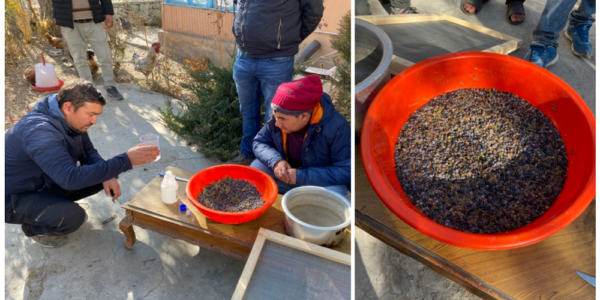Kargil Forest Division Artificially grow Juniper for first time in Kargil
Forest Department Kargil has successfully grown Juniper Seedlings up-to planting height and size under “Project Juniper” in the Special Development Package (SDP), announced a document released by the department recently. The experiment was conducted under the leadership of Divisional Forest Officer, Kargil Forest Division Mohammad Sajid Sultan, IFS.
Kargil forest division over the past year has been carrying out various provenance trials and establishing nursery protocol to raise Junipers in the Nursery. A breakthrough was achieved on June 2021, when finally, one of the trials showed promising results. Taking assistance from techniques established by the Himalayan Forest Research Institute, the local forest department team with a little modification to suit the local environment and climatic conditions, implemented the same in Kargil. The procedure was kept simple, using the help of field staff and locals, which not only trained the field staff in the below said procedure but also imparted the sense of responsibility to carry out this work in the future.
The forest department in its attempt for Artificial Regeneration of Juniper in Kargil followed certain field and nursery protocols, which, as per the officials, is not a standard measure unless it is validated with more similar experience. The tentative protocol includes identification of mature seed-bearing tree on field, cleaning of seeds, drying of berries for 7 days after cleaning, preparing for final treatment by soaking in NaOH solution, removal of the resinous coat using wire mesh, packing of treated seeds in cow dung overwinters, snow treatment of seeds for 2 months, and sowing of seeds in sand beds in a special poly house with sprinkler system. The seeds germinated after 7 months. The department observed that the seedlings reached a height of 2.5 inches in the first growing season. The experts are looking forward to transplanting the seedlings to hypo-cots after two growing seasons.
* Click to Follow Voice of Ladakh on WhatsApp *
The department has newly installed a greenhouse at Kargil for growing Juniper seedlings up to planting height and size. The greenhouse is equipped with automatic cooling fans and fogging system, having a capacity of 30,000 plants.
The Juniper Tree, which is locally known as Shukpa, is one of the very few natives of the cold desert of Ladakh, which are particularly confined over the mountain slopes ridges, valleys of Middle, Northern Western, and Southern Ladakh. The districts of Leh include areas of Da, Hanu, Turtuk, Bogdang, Siachen Belt, Skurbuchan, Achinathang, etc. Kargil district includes areas of Aryan valley (Yaldore, Garkhone, etc.), Kargil town area (Baroo, Poyen, Silmo, etc.), Sankoo, Drass, and Zanskar.
Shukpa being particularly sacred to the culture of the locals finds a special place in all of the religious ceremonies of the cultures across Kargil and Leh districts. Because of its high demand, shukpa is leading to severe degradation of the remaining patches of this native tree. The report by the Forest Department maintained that Anthropogenic influences are greatly manipulating the environment around the growing of juniper trees. The main causes of these manipulations are attributed to culture, tradition, usage, and ignorance; which has greatly impacted the survival of the species and its subsequent regeneration.
The fragrance that the tree leaves, twigs, and branches generate by burning them is used in religious ceremonies, social events, and for welcoming guests. The demand for juniper twigs surges during the festive season of Losar that reportedly leading towards unsustainable harvesting/ smuggling of the species pushing it towards the brink of degradation. Wherein the villagers of Garkhone believe that the rising demand during the festive season leads to smuggling of these trees causing its degradation beyond the capacity of the tree to recuperate.
The report has pointed out two scenarios. On one side, Juniper trees are showing signs of improvement, because of the change in locals’ lifestyles. With the availability and increase in the usage of LPG/Electricity and Solar system in local households, the biotic pressure on firewood and subsequently on junipers has significantly reduced. As a result, the Baroo Ridge, near the Baroo Village, Poyen areas (Garkhone up to Yaldore), Hunderman area, Silmo, and Sherchey area are witnessing a good regeneration.
However, on the other side, the trees are not regenerating significantly enough, for example, areas of Garkhone Gongma, Shoray Longba, Darchik, Lower Poyen Area (Spangchiling), Shoktok (Kargil town area), etc. Which can be attributed to demands for various religious and cultural ceremonies. The trees here are being subjected to acute demand which in the current date is being met unsustainably destroying the species, maintained the report.
Junipers are slow-growing species demanding tremendous attention and expertise with respect to nursery techniques/protocols. Junipers seeds are hard to propagate, and no specific nursery technique has been standardized for Ladakh in particular. The climatic conditions here are fairly different from other high-altitude areas thereby affecting seed collection, treatment, and its subsequent regeneration.
To protect from the degradation of the species, the Forest Department report has suggested certain measures. Identification and prioritization of important juniper areas, check and stop the smuggling of juniper trees in high demand period, restocking of juniper trees by Artificial Regeneration and Assisted Natural Regeneration, provenance trials and establishing nursery protocols for junipers in Ladakh, revitalize Juniper Festival to create awareness for protection and regeneration of Juniper trees, and to use juniper extracts as an alternative to demanding juniper twigs in cultural rituals. Assisted Natural Regeneration (ANR) can be carried out in areas where regeneration is happening but is not establishing itself due to various anthropogenic pressures. This can be achieved by way of fencing the area, patrolling to check damaging of trees due to unsustainable harvesting. However, Artificial Regeneration (AR) is relatively a difficult task, wherein the juniper seedlings are raised in the nursery, grown to a plantable size, and thereafter planted in the areas where regeneration is either absent or significantly poor. Juniper is a very delicate tree and it is challenging to raise in a nursery.

0 Comments